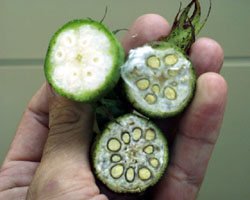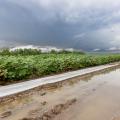Application timing
Harvest-aid application is largely determined by the maturity of the crop, weather conditions, and the harvest schedule. Studies show boll maturity is the single most important factor to consider in timing defoliant applications. Little, or no, boll maturation occurs after the leaves are removed; therefore, premature leaf removal can reduce yield and quality.
 It is generally safe to defoliate when 50 to 60 percent of the bolls are open and the youngest boll you expect to harvest is mature (generally 36 to 40 days old). Under high levels of management, this may occur as early as 45 percent open.
It is generally safe to defoliate when 50 to 60 percent of the bolls are open and the youngest boll you expect to harvest is mature (generally 36 to 40 days old). Under high levels of management, this may occur as early as 45 percent open.
Cutting Bolls-To check boll maturity, identify the youngest age class of bolls you wish to harvest. This will generally be the first position boll 4 to 5 nodes below the terminal. Cut a sample of these bolls in cross section using a sharp knife. A mature boll will be difficult to cut with a sharp knife and the seeds will be completely filled out with no jelly in the center. The presence of a thin, brown line around the seed indicates the seed coat is reaching maturity and the boll is mature enough not to be adversely affected by application of a harvest-aid chemical. When the seeds are mature, the boll is mature. If the seeds are not filled out and some jelly material is present it indicates that the seeds, and the fiber, are not mature. In that case, if the plant is defoliated that age class of bolls will suffer reduced weight, lower mike and perhaps "hard lock" rather than open properly. In some instances, immature bolls may fall from the plant after a harvest aid material is applied.
The pictured boll on is very immature, the one on the right is just about mature and the one on the bottom is very mature - just before opening.
Growers monitoring crop development by plant mapping, or by keeping track of heat unit (DD60) accumulation, may want to use this data to help predict the approximate time to apply defoliants. In doing this, the last effective bloom must be identified. Generally, the last effective bloom occurs at what is referred to as "cutout," which normally occurs 7 to 1 0 days past peak bloom, not at peak bloom. This also corresponds to NAWF-5 (the upper most first position white flower being 5 nodes below the terminal). When this bloom has accumulated 750 DD60's, it generally will be mature enough to defoliate; however, this may vary from year to year and from field to field due to differences in rainfall, soil types, or daily high temperatures. Therefore, the field should be physically examined before a harvest aid is applied.
In general, a boll must be at least 36 to 40 days old (from day of white bloom) before it is safe to defoliate the plants. Bolls less than 36 days old when a harvest aid is applied generally will be reduced in weight, micronaire of its fiber will be reduced, and fiber strength may also be reduced.
Nodes Above Cracked Boll - Nodes above the uppermost first position cracked boll is a new technique used for aiding defoliation timing decisions. This technique involves frequent plant mapping to determine the node of the first position cracked boll and the number of fruiting branches above the cracked boll. Research indicates at least four nodes above the highest first position cracked boll will be mature enough not to be adversely affected by the application of a harvest aid. Therefore, when the first position cracked boll is within four nodes of the last boll you want to harvest, the field can be defoliated. For this system to work, fields must be mapped regularly and enough plants sampled to make the data reliable. This is one of several techniques to help in timing decisions; use accordingly to validate or supplement other techniques. As with any technique, a physical examination of the bolls should precede an application of defoliant.
Make the final decision to apply a harvest aid only after a physical examination of the field in question.
Publications
News
Rainfall at well above normal accumulations is impacting the state’s row crops, mostly in a negative way.
Mike Brown, state climatologist with the Mississippi State University Department of Geosciences, said many areas of the state have had one and a half times the typical amount of rain for this time of year.
STARKVILLE, Miss. -- Expect to see significantly less cotton than usual blooming in Mississippi later this year.




